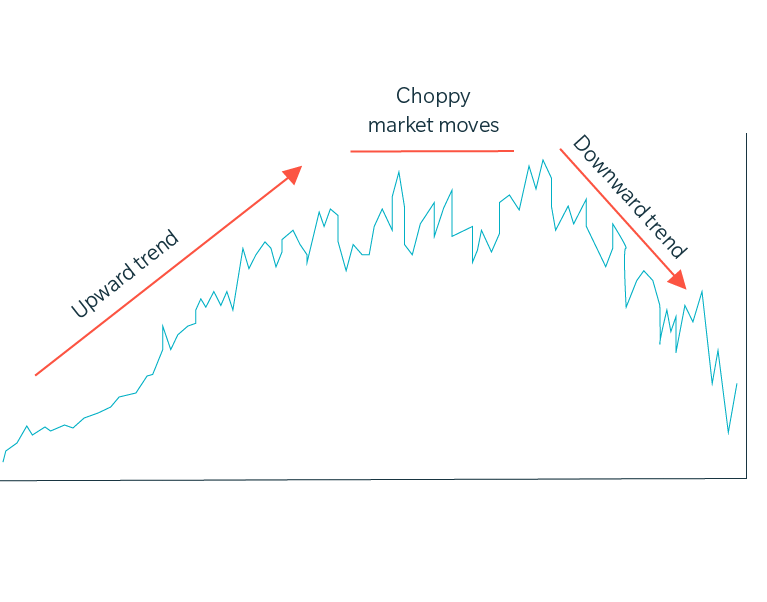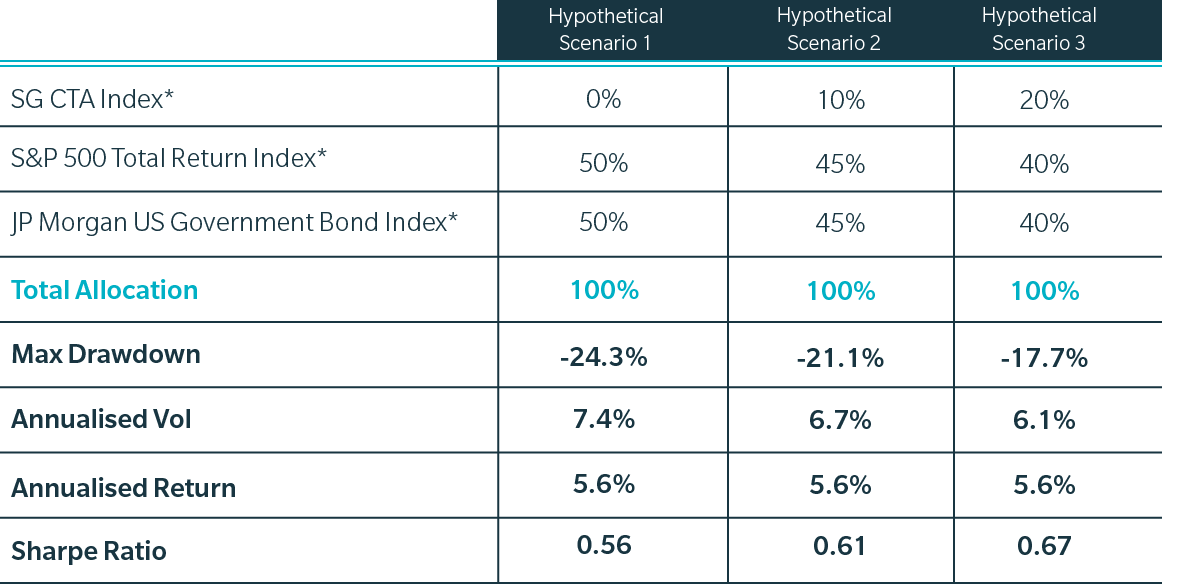Why Managed Futures*?
Introduction
In a turbulent and uncertain market, investment specialists look at ways to try and reduce the stress of second-guessing the Federal Reserve. With the potential to provide low correlation and diversified returns to traditional portfolios**, flows into managed futures have increased. So, what exactly is a managed futures strategy and why might certain investors want to consider it?
*This piece is for the purpose of providing general information and does not purport to be full or complete or to constitute advice.
Past results are not indicative of future results.
Investing in managed futures is not suitable for all investors given the level of risk involved, including the risk of loss.
Diversification does not assure a profit, nor does it protect against a loss.
**References herein to “traditional portfolio” refer to portfolios concentrated in bonds and equities.

Sample of the exposure an investment in managed futures may provide
What is managed futures?
Managed futures is an alternative investment strategy trading liquid global futures and other derivative markets through Commodity Trading Advisors (CTAs). Typically bi-directional in nature, managed futures has the ability to go long or short in any given trade in highly liquid markets. Managed futures has historically provided portfolio diversification due to low correlation over time with equities and bonds.
The core features of managed futures
Diversification
Managed futures can provide diversification to a traditional portfolio* and access to long and short exposure in financial and commodity markets**.
Low correlation
With low correlation over time to bonds and equities, managed futures can potentially smooth out a return profile**.
Liquidity
Managed futures offers access to highly liquid markets which can allow for exposure to market moves**.
Bi-directionality
CTAs can take long or short positions across markets**.
*References herein to “traditional portfolio” refer to portfolios concentrated in bonds and equities.
**Past results are not indicative of future results.
Investing in managed futures is not suitable for all investors given the level of risk involved, including the risk of loss.
Diversification does not assure a profit, nor does it protect against a loss.
Liquidation of contracts is subject to market conditions.

For illustrative purposes only
How do managed futures work?
The most prevalent trading strategy for CTAs are systematic strategies. These contrast with how many bond and equity investment managers make investment decisions on a discretionary “value” basis. Trendfollowing, which is an example of a managed futures trading style, is a 'momentum' investment strategy that looks for signals in the price movement of a security, whether that is up or down, over a period of time. Using price data, such as moving averages, price breakout and other trading signals, trendfollowing managers determine whether an asset is potentially moving on an up or down trend.
Why allocate?
Managed futures has a low correlation to equities and bonds over time and can have a three-fold impact on a traditional portfolio* by potentially increasing risk adjusted returns, lowering volatility and mitigating drawdowns. It is important to note that an investment in managed futures can be volatile; however, for managed futures investors an allocation may offer certain investors a balance between diversification and volatility.
*References herein to “traditional portfolio” refer to portfolios concentrated in bonds and equities.
As seen in the table allocating a percentage of a hypothetical portfolio to managed futures can potentially:
- Lower the total volatility
- Reduce the drawdown
- Improve the portfolio Sharpe
January 2000 to August 2022

as at 31st August 2022
Source: Abbey Capital and Bloomberg. For a description of all indices referenced please see "Description of Indices" below.
The above table is for illustrative purposes only. Indices referred to in this article are not directly investible, are not based on the entire population of equities, bonds or CTAs and are not indicative of the performance of any particular manager or fund. Furthermore, these indices may not be directly comparable. As a result, there are inherent limitations with using these indices for representative purposes and the above is shown for illustrative purposes only. None of the funds managed by Abbey Capital are benchmarked against any index, including the indices shown.
The table shows that adding a hypothetical allocation to managed futures (represented by the SG CTA Index) to a hypothetical portfolio of bonds and equities, between January 2000 and July 2022 reduced portfolio volatility and drawdown and improved risk-adjusted portfolio returns (Sharpe ratio). Performance figures shown above that combine S&P 500 Index, JP Morgan US Government Bond Index and SG CTA Index are hypothetical. While based on the actual historical data of each, results are purely the product of simulation and there was no actual trading or actual profits for these scenarios. Please see the hypothetical performance disclosure in bold below for additional information. The SG CTA Index is derived from data which is self-reported by investment managers based on the performance of privately managed funds. In contrast, the S&P 500 Index and the JP Morgan US Government Bond Index comprise publicly traded securities. As a result, these indices may not be directly comparable and the above is shown for illustrative purposes only. For further information about the limitations of hypothetical performance results please see below in bold.
Let's talk
If you'd like to find out more about Managed Futures or our products, please fill out the form and we'll be in touch.
Looking to find out more?
Important Information, Risk Factors & Disclosures
This piece is for the purpose of providing general information and does not purport to be full or complete or to constitute advice.
Abbey Capital is a private company limited by shares incorporated in Ireland (registration number 327102). Abbey Capital is authorised and regulated by the Central Bank of Ireland as an Alternative Investment Fund Manager under Regulation 9 of the European Union (Alternative Investment Fund Managers) Regulations 2013 (“AIFMD”). Abbey Capital is registered as a Commodity Pool Operator and Commodity Trading Advisor with the U.S. Commodity Futures Trading Commission (“CFTC”) and is a member of the U.S. National Futures Association (“NFA”). Abbey Capital is also registered as an Investment Advisor with the Securities Exchange Commission (“SEC”) in the United States of America. Abbey Capital (US) LLC is a wholly owned subsidiary of Abbey Capital. None of the regulators listed herein endorse, indemnify or guarantee the member’s business practices, selling methods, the class or type of securities offered, or any specific security.
While Abbey Capital has taken reasonable care to ensure that the sources of information herein are reliable, Abbey Capital does not guarantee the accuracy or completeness of such data (and same may not be independently verified or audited) and accepts no liability for any inaccuracy or omission. Opinions, estimates, projections and information are current as on the date indicated on this piece and are subject to change without notice. Abbey Capital undertakes no obligation to update such information as of a more recent date.
Pursuant to an exemption from the CFTC in connection with accounts of qualified eligible persons, this report is not required to be, and has not been, filed with the CFTC. The CFTC, the SEC, the Central Bank of Ireland or any other regulator have not passed upon the merits of participating in any trading programs or funds promoted by Abbey Capital, nor have they reviewed or passed on the adequacy or accuracy of this report.
Risk Factors: This brief statement cannot disclose all of the risks and other factors necessary to evaluate a participation in a fund managed by Abbey Capital. It does not take into account the investment objectives, financial position or particular needs of any particular investor. Trading in managed futures is not suitable for all investors given its speculative nature and the high level of risk involved, including the risk of loss. Prospective investors should take appropriate investment advice and inform themselves as to applicable legal requirements, exchange control regulations and taxes in the countries of their citizenship, residence or domicile. Investors must make their own investment decision, having reviewed the private placement memorandum carefully and consider whether trading is appropriate for them in light of their experience, specific investment objectives and financial position, and using such independent advisors as they believe necessary. The attention of prospective investors in the fund is drawn to the potential risks set out in the private placement memorandum of the fund under the heading ‘Risk Factors’.
Where an investment is denominated in a currency other than the investor’s currency, changes in the rates of exchange may have an adverse effect on the value, price of, or income derived from the investment. Past performance is not a guide to future performance. Income from investments may fluctuate. The price or value of the investments to which this report relates, either directly or indirectly, may fall or rise against the interest of investors and can result in a total loss of initial investment. Certain assumptions may have been made in this analysis, that have resulted in the returns detailed herein. No representation is made that any returns indicated herein will actually be achieved.
Potential investors are urged to consult with their own professional advisors with respect to legal, financial and taxation consequences of any specific investments they are considering in Abbey Capital products.
The information herein is not intended to and shall not in any way constitute an invitation to invest in any of the funds managed by Abbey Capital. Any offer, solicitation or subscription for interests in any of the funds managed by Abbey Capital shall only be made in a private offering to qualified investors pursuant to the terms of the relevant private placement memorandum and subscription agreement and no reliance shall be placed on the information contained herein.
This piece and all of the information contained in it is proprietary information of Abbey Capital and intended solely for the use of the individual or entity to whom it is addressed or those who have accessed it on the Abbey Capital website. Under no circumstances may it be reproduced or disseminated in whole or in part without the prior written permission of Abbey Capital.
Certain assumptions may have been made in this analysis, that have resulted in the returns detailed herein. No representation is made that any returns indicated herein will actually be achieved.
HYPOTHETICAL PERFORMANCE RESULTS HAVE MANY INHERENT LIMITATIONS, SOME OF WHICH ARE DESCRIBED BELOW. NO REPRESENTATION IS BEING MADE THAT ANY ACCOUNT WILL OR IS LIKELY TO ACHIEVE PROFITS OR LOSSES SIMILAR TO THOSE SHOWN. IN FACT, THERE ARE FREQUENTLY SHARP DIFFERENCES BETWEEN HYPOTHETICAL PERFORMANCE RESULTS AND THE ACTUAL RESULTS SUBSEQUENTLY ACHIEVED BY ANY PARTICULAR TRADING PROGRAM. ONE OF THE LIMITATIONS OF HYPOTHETICAL PERFORMANCE RESULTS IS THAT THEY ARE GENERALLY PREPARED WITH THE BENEFIT OF HINDSIGHT. IN ADDITION, HYPOTHETICAL TRADING DOES NOT INVOLVE FINANCIAL RISK, AND NO HYPOTHETICAL TRADING RECORD CAN COMPLETELY ACCOUNT FOR THE IMPACT OF FINANCIAL RISK IN ACTUAL TRADING. FOR EXAMPLE, THE ABILITY TO WITHSTAND LOSSES OR ADHERE TO A PARTICULAR TRADING PROGRAM IN SPITE OF TRADING LOSSES ARE MATERIAL POINTS WHICH CAN ALSO ADVERSELY AFFECT ACTUAL TRADING RESULTS. THERE ARE NUMEROUS OTHER FACTORS RELATED TO THE MARKETS IN GENERAL OR TO THE IMPLEMENTATION OF ANY SPECIFIC TRADING PROGRAM WHICH CANNOT BE FULLY ACCOUNTED FOR IN THE PREPARATION OF HYPOTHETICAL PERFORMANCE RESULTS AND ALL OF WHICH CAN ADVERSELY AFFECT ACTUAL TRADING RESULTS. HENCE NO REPRESENTATION IS BEING MADE THAT ACTUAL PROFITS OR LOSSES WILL BE SIMILAR TO THOSE SHOWN IN THIS REPORT.
Description of Indices
S&P 500 Total Return Index (Start Date: Feb-1988) Used to represent US equities:
The S&P 500 Total Return Index (“S&P 500 TR”) is a market capitalisation-weighted price only index, comprised of 500 widely-held common stocks listed on the NYSE and NASDAQ. The performance data of the S&P 500 Total Return Index includes the reinvestment of all dividends but does not subtract fees or expenses.
JP Morgan US Government Bond Index (Start Date: Dec-1985) Used to represent US Treasuries: The JP Morgan US Government Index is a leading measure of US government bond market performance. The index measures the total return of US Treasury securities across the whole yield curve.
SG CTA Index (Start Date: Jan-2000) Used to represent Managed Futures: The SG CTA Index is an equally weighted index. It is calculated daily using a pool of CTAs selected from the larger managers that are open to new investment. The index is rebalanced annually
For more information on how we are committed to protecting and respecting your privacy, please review our Privacy Notice.

Suite 212,
New York,